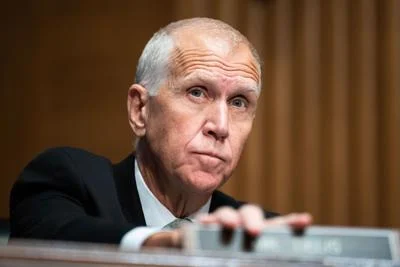Who is Thom Tillis? The question has gained fresh relevance as North Carolina Sen. Thom Tillis announced on June 29, 2025, that he won’t seek re-election in 2026, following a high-profile clash with former President Donald Trump. Tillis, a Republican serving the Tar Heel State since 2015, has been a polarizing figure, balancing conservative priorities with occasional bipartisan moves that frustrated his party’s base. His decision to step away, driven by his vote against Trump’s “Big Beautiful Bill” and its steep Medicaid cuts, has ignited speculation about North Carolina’s political future. This article dives into who Thom Tillis is, his career, and the latest developments shaping his legacy.
Who Is Thom Tillis? A Political Snapshot
To understand who Thom Tillis is, start with his roots. Born in 1960 in Jacksonville, Florida, Tillis grew up in a working-class family, eventually settling in North Carolina. Before politics, he built a career in business, working as a partner at PricewaterhouseCoopers and later at IBM. His political ascent began in 2006 with a seat on the Cornelius Town Board, followed by a stint in the North Carolina House of Representatives, where he served as Speaker from 2011 to 2014. Elected to the U.S. Senate in 2014 after defeating incumbent Democrat Kay Hagan, Tillis secured a second term in 2020 against Cal Cunningham in a tight race.
Tillis’ Senate tenure reflects a complex identity. He’s championed conservative causes like the 2017 Tax Cuts and Jobs Act and supported Trump’s judicial nominees, including Supreme Court justices. Yet, his willingness to cross party lines—backing the Respect for Marriage Act in 2022 and infrastructure investments—has drawn criticism from hardline Republicans. In 2023, the North Carolina GOP censured him for “blatant violations” of party principles, highlighting the tension that defines who Thom Tillis is: a senator caught between pragmatism and party loyalty.
The Trump Clash and Tillis’ Exit
The question of who Thom Tillis is took a dramatic turn with his recent decision to exit the 2026 Senate race. On June 29, 2025, Tillis announced he would not seek a third term, citing frustration with Washington’s gridlock and a desire to focus on family. The tipping point? His vote against Trump’s signature tax and spending bill, which included deep Medicaid cuts that Tillis argued would harm North Carolina’s 600,000 residents covered under the state’s 2023 Medicaid expansion. Trump retaliated swiftly on Truth Social, branding Tillis a “grandstander” and promising to back a primary challenger, with names like Lara Trump floating as possibles.
This clash underscores the challenges Tillis faced in navigating Trump’s influence over the GOP. His announcement has sparked debate about the party’s direction, with analysts noting that Tillis’ exit reflects a broader trend of moderate Republicans stepping aside. For voters asking who Thom Tillis is, his departure paints him as a figure unwilling to bend fully to partisan pressures, even at the cost of his political future.
Key Point Summary
- Thom Tillis, North Carolina senator since 2015, won’t run in 2026.
- His opposition to Trump’s Medicaid cuts triggered a public feud.
- Tillis’ career blends conservative wins with bipartisan efforts.
- His exit sets up a heated 2026 Senate race in North Carolina.
What’s Next for North Carolina?
Tillis’ decision not to run has turned North Carolina’s Senate race into a 2026 midterm battleground. The state, a Republican-leaning but competitive battleground, is now a prime target for both parties. Republicans are scrambling to find a successor, with Rep. Pat Harrigan, a first-term congressman, expressing interest. Trump’s pledge to handpick a candidate suggests his influence will loom large, with speculation about Lara Trump or other loyalists entering the race. Democrats, meanwhile, see an opening. Former Gov. Roy Cooper and Rep. Wiley Nickel are potential contenders, with the Democratic Senatorial Campaign Committee calling Tillis’ exit a “game-changer.”
The stakes are high. North Carolina’s shifting demographics and recent Democratic gains in urban areas like Raleigh and Charlotte make the seat winnable for either side. For those still asking who Thom Tillis is, his departure highlights his role as a bridge between old-school Republicanism and the Trump-era GOP, a bridge that ultimately couldn’t withstand the strain.
Tillis’ Legacy and Final Chapter
As Thom Tillis prepares to leave the Senate in 2027, his legacy is a study in contrasts. He takes pride in conservative achievements, like tax reform and judicial appointments, but also in bipartisan wins, such as mental health funding and marriage equality legislation. His final 18 months will focus on serving North Carolina, particularly on issues like flood recovery, which Trump criticized him for neglecting. Tillis has vowed to remain independent, free from re-election pressures, and to “call it like I see it.”
For those wondering who Thom Tillis is, he’s a senator who tried to carve a middle path in a polarized era, often at great personal cost. His exit marks the end of a decade-long tenure and the start of a new chapter for North Carolina politics. The 2026 race will test whether his brand of pragmatism has a place in today’s GOP or if Trump’s vision will dominate.
Keep up with North Carolina’s Senate race and the candidates shaping its future by following the latest updates.
